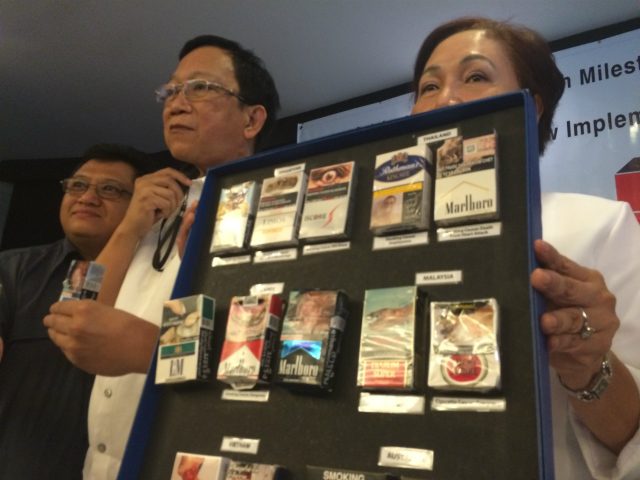SUMMARY
This is AI generated summarization, which may have errors. For context, always refer to the full article.

MANILA, Philippines – As the Graphic Health Warnings Law takes effect Thursday, March 3, tobacco control advocates warned firms manufacturing cigarette packs not to skirt the law.
“Mark this day, this should be the start of your cigarette packs bearing graphic health warnings. You have no option except to comply. We expect nothing less from you. We are watching you, and we have the capacity to monitor you,” said Rommel Arriola of the Framework Convention on Tobacco Control Alliance, Philippines (FCAP).
According to Arriola, the FCAP is the non-governmental organization sitting in the Philippines’ Inter-Agency Committee on Tobacco tasked to monitor the tobacco industry’s compliance with the law.
The implementing rules and regulations of Republic Act 10643 or the Graphic Health Warnings Law include two important dates for advocates:
- March 3, 2016 – Starting this date, no tobacco product packaging shall be withdrawn from the manufacturing facilities or imported into the Philippines customs territory without graphic health warnings.
- November 4, 2016 – Starting this date, retailers and sellers of tobacco products shall ensure the removal from all displays of noncompliant tobacco products manufactured, imported, distributed, or sold by them.
Manufacturers have 8 months to exhaust their stocks of packs that only bear text warnings. Dr Ulysses Dorotheo of the Southeast Asia Tobacco Control Alliance (SEATCA) said that ideally, scary cigarette packs should already be seen by the public today.
“Dapat kung nagrerelease sila [manufacturers] ngayon…because if you go to supermarkets, you ask them how often is the delivery to them, usually every couple of weeks nagdedeliver ng bagong stock. So we expect within the next several weeks, makikita na natin yung bagong warnings,” he explained.
(If manufacturers are releasing packs with graphic health warnings, it should be today…because if you go to supermarkets, you ask them how often is the delivery to them, usually manufacturers deliver new stocks every couple of weeks. So we expect within the next several weeks we will already see the new warnings.)
Dorotheo, SEATCA’s Framework Convention on Tobacco Control (FCTC) program director, noted that according to smokers themselves, even cigarettes become “stale” or “hindi masarap” after just 2 to 3 months.
Lawyer Patricia Miranda of HealthJustice said it’s also unlikely for cigarette packs with only text warnings to stay in the shelf longer than 3 months from today “precisely because it is addictive.”
“So if we still see non-compliant tobacco packages in November 2016, isa lang po ibig sabihin nun (that only means one thing): that the tobacco companies did not start printing today,” she added.
Miranda also warned manufacturers against placing misleading descriptors on their cigarette packs that will confuse the public into thinking a tobacco product may be healthier or safer.
“There is no safe cigarette,” she said.
Monitor tobacco firms
With 240 Filipinos dying every day due to major tobacco-related diseases, health advocates say picture-based warnings are needed to warn Filipinos who cannot read or understand the current text warnings being used on cigarette packs.
The Philippines is a signatory to the FCTC of the World Health Organization (WHO), which requires the implementation of “large, rotating health warnings on all tobacco product packaging and labeling.”
Dorotheo said the Philippines should have had graphic health warnings on cigarette packs as early as 2008.
But President Benigno Aquino III only signed RA 10643 in July 2014, and the law only took effect almost two years after its enactment since templates were revised months after the initial publication.
According to WHO standards, graphic health warnings should be placed on 50% or more – but not less than 30% – of both front and back display areas of a cigarette pack.
The Philippine law meets this standard, as it requires that warnings occupy 50% of both front and back panels. They will, however, be placed on the lower portion of a cigarette pack and not at the top as suggested by the WHO. (READ: INFOGRAPHIC: What a scary cigarette pack in PH will look like)
A maximum of 12 variations of the warnings will be rotated every 24 months.
Dorotheo also urged the public to hold accountable government agencies, especially the Bureau of Internal Revenue (BIR), and make sure they are doing their part in monitoring the compliance of tobacco firms.
Under the law, the BIR is in charge of making sure that cigarette stamps are not affixed on packages that do not comply with the Graphic Health Warnings Law. – Rappler.com
Add a comment
How does this make you feel?
There are no comments yet. Add your comment to start the conversation.